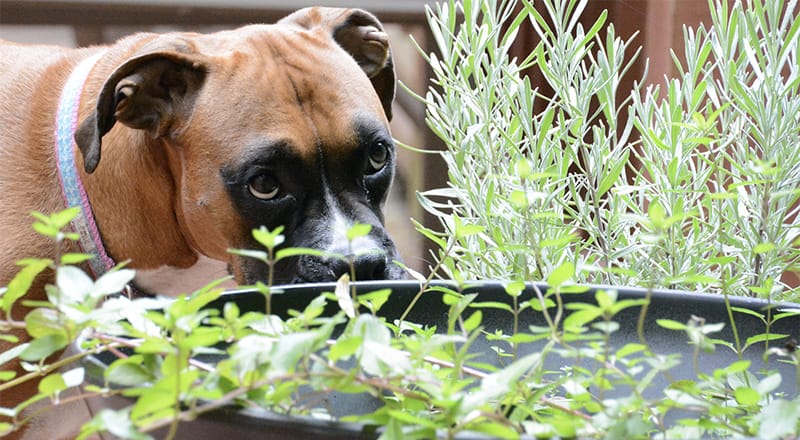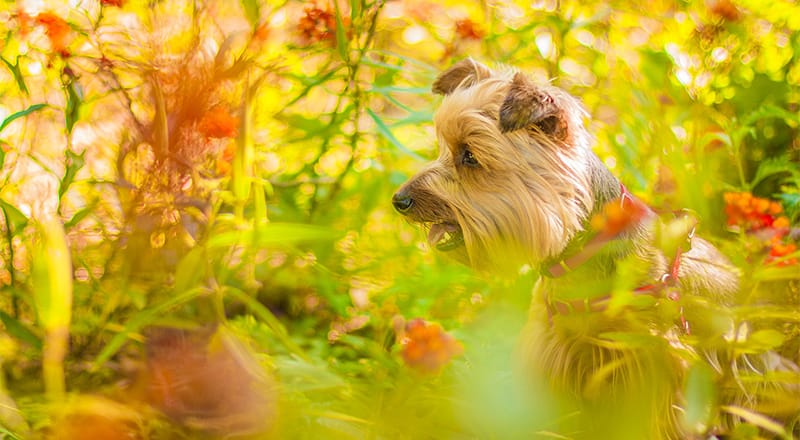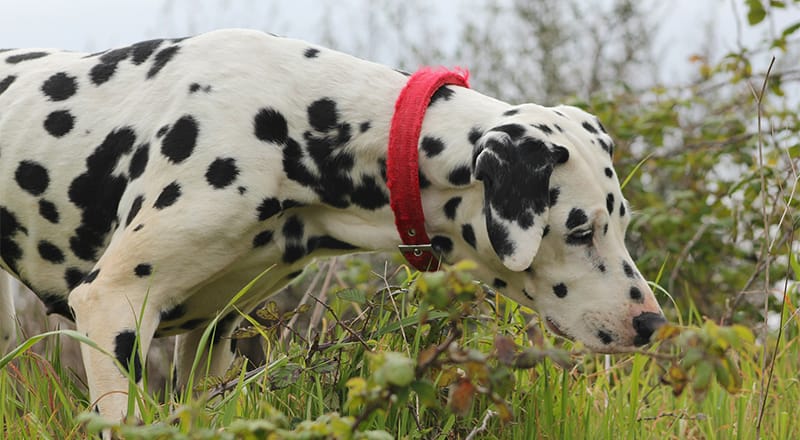Beware! 21 Common Plants Poisonous to Dogs
Published: Last updated: by Jessi Larson Affiliate Disclosure: We hope you love the products we've recommended! As an Amazon Associate we earn a small share from qualifying purchases.Dogs love to explore and chew things, especially when they’re younger. And for whatever reason, many dogs enjoy munching on grass and other vegetation.
My dog Toby is obsessed with sneaking a bite of the long grass that pops up along our walking trails. For the most part, I let him grab a few bites before pulling the leash away. The only downside – and total TMI alert – is that every once and a while he gets a bit backed up.
I do fear, however, that he’ll accidentally get into a plant that is poisonous and become sick. The problem is I have a hard time telling which plants are fine and which ones are toxic.
To get to the bottom of it, I did some digging through the Pet Poison Helpline, ASPCA and The Humane Society and found the 21 most common plants poisonous to dogs.

Aloe Vera – Aloe Vera is great for burns, but toxic when ingested by pets. Eating Aloe Vera can cause vomiting, diarrhea, depression and tremors.
Azalea – A flowering shrub, the Azalea is great on the eyes but hard on the stomach for animals. Eating just a few leaves can lead to some pretty serious problems.
Baby’s Breath – Used as a filler in flower arrangements, Baby’s Breath looks as cute as can be. Don’t let this fool you, though. Baby’s Breath contains gastrointestinal toxins that can cause vomiting and diarrhea in your dog. The symptoms are generally mild, but still unpleasant.
Begonia – A popular garden and container plant, the Begonia is another poisonous plant for pups. The tubers, in particular, are the most toxic part.
Caladium or “Elephant Ear” – Caladium, nicknamed Elephant Ear because it looks like, well, an elephant ear, is a colorful, cool-looking plant that you should keep your dog away from. When ingested, it can cause burning of the mouth, lots of drooling, and vomiting.
Chrysanthemum – With gorgeous fall blooms, the Chrysanthemum is a simply stunning plant. Eating Chrysanthemum is rarely fatal for furbabies, but it does result in some pretty yucky symptoms like stomach ache and diarrhea, so be careful.
Daffodil – The bulb is the most toxic part of the Daffodil and can cause sweating, drooling, vomiting, and even worse, low blood pressure, tremors and cardiac arrhythmias.
Dieffenbachia – Dieffenbachia, affectionately called “Dumb Cane,” is a common houseplant that’s very easy to maintain. Unfortunately, it’s another example of a poisonous plant for dogs. Chewing on the leaves can cause severe swelling and burning in the mouth and difficulty breathing.

English Ivy – English Ivy is a common indoor decorative plant that can be toxic to dogs if eaten. It contains a toxic called triterpanoid saponin that can lead to irritation of the mouth and gastrointestinal tract when consumed.
Gladiolus – Gladiolus is a great addition to any garden and also helps beautify a flower arrangement. The bulb is very toxic to pets, however, so watch out.
Geranium – Toxicity in Geraniums is caused by the chemical linalool and the alcohol geraniol. Chewing on this plant causes telltale poisoning signs such as an upset stomach, throwing up, itchy skin and lethargy.
Hosta – Hostas are a common staple in many people’s yards. We have a ton of them around the house. Luckily, Toby hasn’t developed a taste for them because they can be quite poisonous for pups.
Jade plant – Vomiting, depression and incoordination are common symptoms of jade plant poisoning. If you have such a plant on your property, remain cautious for the sake of your canine.
Milkweed – Milkweed is great for monarch butterflies, but not so great for dogs. Even the water in a vase of Milkweed has been reported to cause toxicosis.
Morning Glory – A common climbing plant with cool trumpet-shaped flowers, the Morning Glory can cause hallucinations, gastrointestinal upset, agitation, tremors and disorientation, among other things. Yikes!

Oleander – Oleander is both pretty and poisonous. All parts of the plant contain a highly toxic cardiac glycoside that causes mild to severe issues for furbabies.
Poinsettia – How gorgeous are Poinsettias during Christmas time? You’ve probably heard that they are highly toxic to pets. That is true, but it’s not as severe as you’d think. More like a mild discomfort. Still, you shouldn’t let your pup chomp on Poinsettia leaves anytime soon.
Rhubarb – A common plant grown for edible consumption, Rhubarb is also known as the pie plant. The leaves contain soluble oxalate crystals. The crystals are less prevalent in the stalk, which is why rhubarb stems are edible but the leaves are not.
Sago Palm – A popular landscaping plant and also used for bonsai, the Sago Palm is apparently very tasty to animals but also highly toxic. All parts are poisonous, but the seeds are the worst. Symptoms include vomiting, increased thirst, liver damage or failure, and even death.
Tomato Plant – Growing tomatoes in your garden is a wonderful way to bring fresh foods into your home. Just keep them away from your furry family members. Tomato plants are only mildly toxic, but still, you can do without doggy diarrhea and tummy aches.
Tulip – The bulb of the tulip has the highest concentration of toxins. So if your dog likes to dig in the garden, be cautious.
What to do if your dog ingests one of these plants
If you suspect your dog has been poisoned by a plant, take them to a vet immediately. If the symptoms are pretty mild but you suspect something might be awry, it’s still a good idea to call your vet or the Pet Poison Helpline. It’s always better to be safe than sorry!



 Getting a New Dog?
Getting a New Dog?